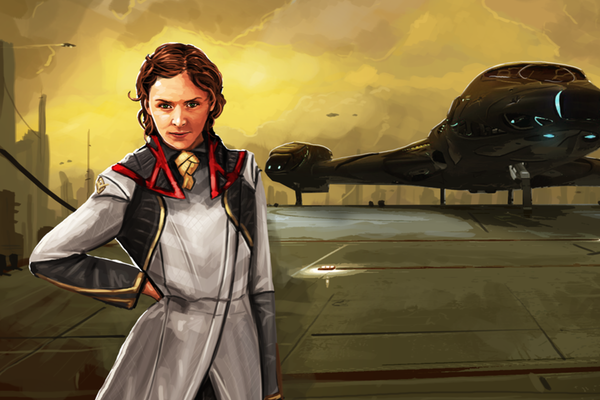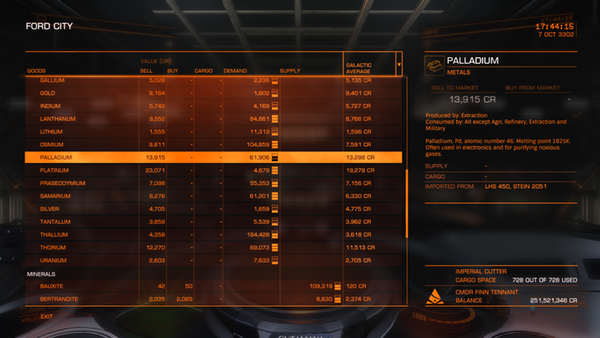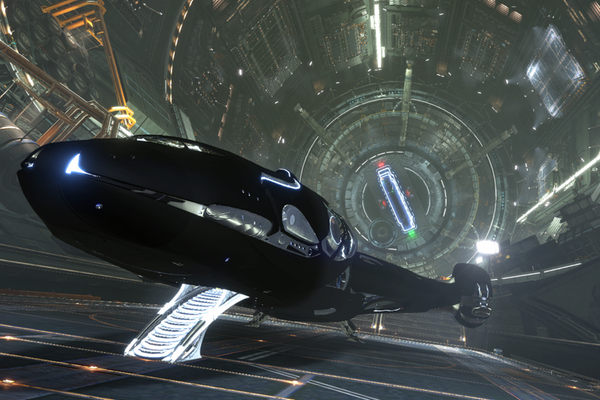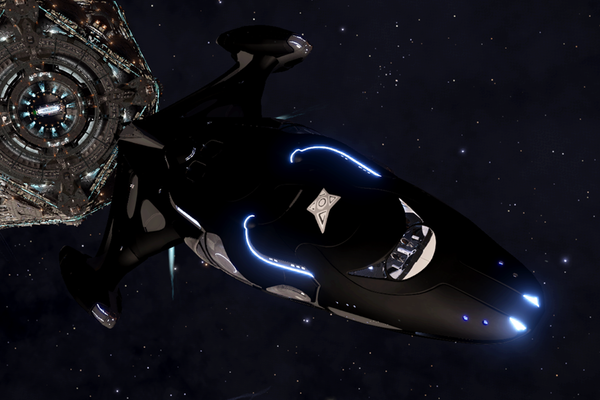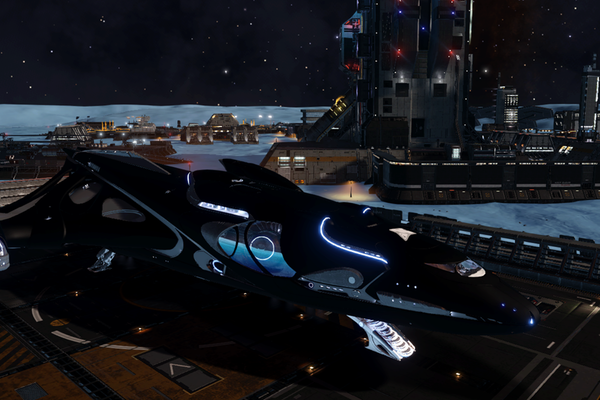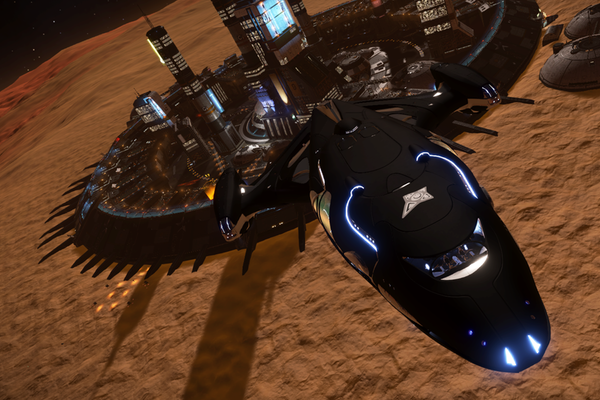Of all the legal careers available to a pilot in the future Milky Way of Elite: Dangerous, the Trader has the greatest potential for steady and large Credit gains. It’s not a glamorous or even exciting job (until you get Interdicted by a Pirate), but to the citizens of the innumerable Outposts, Stations, and Installations in the vast Bubble of human space it is an invaluable one.
Miners in mining outposts need beer, doctors in outbreak systems need medicine, scientists in far flung systems need research equipment, fashionistas in the heart of Imperial space need clothes, soldiers in war torn systems need armor and weapons; everyone needs something and you’re just the frugal merchant to provide. The trick is knowing where to buy a certain commodity cheaply, and then where to sell it with the most demand. Thankfully there are a host of tools, in-game and out, to help you get the best price for that load of Biowaste (yeah, I’m not even kidding).
The Job
Everything a Trader does in Elite: Dangerous centers around the Commodities Market in the Starport Services of stations that have one, and, more than any other career in Elite: Dangerous, the Trader is well served by both in-game and 3rd party resources to aid them in their acquisition of Credits. While there are missions on the Mission Board to transport or source Haulage to or from other systems (and this isn’t a bad way to start out trading), what I’ll be discussing here is bulk trading. As a bulk Trader (hereafter referred to as, simply, Trader) you buy and sell commodities through the Commodities Market, in bulk, with a source and destination of your own choosing. How does the Trader make Credits doing this, you ask? Well, to quote Warren Buffet, “Rule No.1: Never lose money. Rule No.2: Never forget rule No.1.” It also doesn’t hurt to have an at least passing familiarity with the Ferengi Rules of Acquisition.
In all seriousness, the Trader, in Elite: Dangerous, makes Credits by spending Credits. Ok, ok, I promise to stop with the aphorisms. Man, tough crowd. But, what I said is true; the Trader makes Credits by buying (spending Credits) a given commodity at one Outpost, Station, or Installation, and then selling (making Credits) at another Outpost, Station, or Installation. The key to that transaction is getting said commodity for the lowest possible price at the first station, then selling it to the second station for the highest price possible.
Finding those price imbalances, commodities that are overproduced in one place and in demand in another, is, unfortunately for the Trader, the bulk of their job and potentially the least exciting part. Thankfully there are lots of tools to help, which we’ll go over a little later in the post.
The most exciting part, actually acquiring the commodities and then delivering them to the point of sale, is short lived and can be both nail-biting and repetitive, depending on what the Trader is hauling and the systems they’re moving through. A fast ship with lots of cargo space makes it quicker and safer.
The Ship
Most Traders in Elite: Dangerous are deeply concerned with Credits per Hour, that is, how many Credits are they earning per hour of docking with stations, purchasing commodities, traveling to other stations, docking with those stations, and selling their haul. Docking with stations quickly and efficiently is a matter of practice, but there are two factors that a Trader must also consider and those are: how many Frame Shift jumps are there between source and destination systems (no more than 2 or 3 jumps … 1 is preferred), and how far do they need to travel in supercruise from the point where they enter a system to the actual source or destination Outpost, Station, or Installation. The wise Trader generally keeps this under 2000ls (light seconds). One of the biggest influencing factors in this is the Trader’s ship.
The lighter and faster a ship is, the further it can jump and the easier time it has outrunning Pirates, but Trader’s are almost always loaded to the gills with cargo. Cargo adds mass to a ship, just as its components and modules do. This presents the Trader with a difficult problem to solve. In most cases the solution is to outfit the ship with only the bare minimum, in module sizes and ratings, it needs to do the job.
Traders don’t stop and fight; they run. Hardpoints can be tossed right from the start because they weigh a lot and they draw power. This will, in turn, allow the Trader to outfit a smaller, lighter Power Plant. Life Support and Sensors? The bare minimum D rated will do. Shields? Again, the Trader runs, so the smallest D rated Shield that will cover the ship will be enough to protect it from any accidental bumps and scrapes during docking. Unless the shipping lanes are infested with Pirates, and then it’s a judgement call. Fuel Scoop? Pah! A Trader should never be traveling so far that they’ll need one.
Traders haul cargo, so every Optional Internal compartment, apart from the one set aside for shields, should be filled with the largest Cargo Racks they can accept. The best Thrusters and Power Distributor a ship can outfit will go a long way toward helping the Trader stay ahead of Pirates. Chaff Launchers, Point Defense, and Electronic Countermeasures will also help to dodge gimbaled weapons fire, missiles, and Hatch Breaker Limpets.
In short, the Trader makes as much room as possible for Cargo, and only takes the equipment they need to get from point A to point B efficiently and safely.
Doing the Work …
Writers write; artist art; dog walkers walk; Traders trade. (ok, I lied about the aphorisms). A Trader should never be traveling from one place to another without a hold full of stuff folks want at the other end. It’s going to happen now and again; there are just some people who don’t want for anything, or at least don’t want anything from there. But, in those instances the Trader should feel those empty Cargo Racks in the pit of her stomach. Even if the profit from a Trade will only cover to cost of fuel, it’s better than nothing. To paraphrase Rule of Acquisition No. 18, “A Trader without profit is no Trader at all.”
In Game, a Trader’s most valuable tool for sniffing out profit is the Galaxy Map. The Galaxy Map can be accessed from the left hand HUD (default key binding 1). Once the Galaxy Map is open, clicking on the tab with the cluster of stars will bring up the filtering mode for the map. Clicking on MAP will bring up some options that allow you to filter system display by a whole slew of options including State, Allegiance, Economy, and Trade Data availability. Additionally, Trade Routes between the system the Trader is currently in and neighboring systems can be shown by clicking the Show Trade Routes option. This will display color coded arcs, flowing in the direction of trade. Finally, those Trade Routes can be further filtered by the types of commodities being traded. Clicking on a system with Trade Data available (if you filtered the systems by Trade Data Shop) will allow you to purchase Trade Data on that system by clicking the opposing arrows icon. Even at the system level of the map, you can see (by selecting a station and then clicking on the information tab with the four horizontal lines) a station’s State, Economy, and Exports and Imports. Once you know what systems are exporting and importing, then you know what to buy and where to sell it.
Metals, Consumer Items, Technology, and Medicines are some of the higher profit commodities. That’s not to say that trading in another type of commodity won’t be worth it (I’ve had runs where I made millions trading in Tobacco), it’s simply that by and large most people want the afore mentioned commodities so the Trader will have more opportunities to make sales. One of the highest paying commodities is Slaves (both unsanctioned and Imperial varieties), but, for many players, trading in Slaves is a moral question, and many players choose not to have any part of it. That choice is entirely up to each individual Trader. Slavery is illegal in all Federation systems, most Alliance systems, and even some Imperial systems (those controlled by Aisling Duval), so it’s often best left to Smugglers anyway. The Background Simulation and Powerplay have a heavy impact on system States, and the system State often determines what folks in those systems want. Even if you choose to use 3rd party tools to help you trade, the information in the Galaxy Map is always useful.
That said, new Traders would most certainly not be harmed by availing themselves of some of the tools community members work hard to maintain. Before I point a few of these tools out, though, I want to recommend that every Trader in Elite: Dangerous (whether you use 3rd party tools or not) run EDMarketConnector. EDMC is a very lightweight and safe (I’ve used it for over a year) app that parses the game’s log files, extracts the market data (along with Shipyard and Outfitting data, and a host of other relevant pieces of information) for every station a player visits, then uploads that data to the Elite Dangerous Data Network. EDDN is, in turn, used by most of the 3rd party tools created for the game to do everything from displaying the best trade routes, to showing where to buy ships and modules, and even what Facilities a particular Station might have available. EDMC is a quiet little app that requires almost no interaction, once set up, and provides a wealth of information to the Elite: Dangerous community at large. I think every pilot should be running it, and if you use 3rd party tools regularly and aren’t running it … yeah, you’re that person.
The Elite Dangerous Database is, and I think most players would agree, the defacto source for all things concerning the state of The Bubble in Elite: Dangerous. It is the front end for accessing all the data collected by EDDN, and the default location that information is sent by EDMC. While it does have a web based UI for entering that data manually (ROSS), its strength is the near real time information it gathers from players using EDMC. With EDDB, players can access almost all of the information available about Systems, Bodies, Outposts, Stations, Installations, Commodities, Local Factions, and Ship and Module availability. Using its tools, Single Hop Route, Multi Hop Route, and Loop Trade Route, a Trader can, in conjunction with data gathered in game using the above describe filtering techniques on the Galaxy Map, determine what are the most profitable trades in and around the system they are currently in or a system they intend to travel to. In these tools you can filter trades by commodity, distance from arrival point to station, landing pad size, system State, and even set it up so they are only making trades with certain Superpowers or Powers. There are two downsides to EDDB: one is that it is completely dependent on data gathered by EDDN, and even when players use EDMC its data is only up to date for systems and stations players are visiting, and, because many Traders use EDDB, profitable routes that it has listed can quickly become saturated; stations always have a limited number of each commodity and a limited demand. Prices fluctuate daily, and even hourly. Still, it is a fantastic tool and one I rely heavily on even after reaching Elite Trader.
Elite Trade Net is another fantastic tool that relies on the data gathered by EDDN and, by extension, EDMC. It takes the idea of EDDB’s Loop Trade Route tool, but runs it through a much more sophisticated algorithm to generate an interactive map of trade loop routes based on an origin system the user enters. It will also import the specs of the Trader’s ship, from Coriolis.Io or E:D Shipyard, to allow for the calculation of the amount of jumps between systems, total profit of hauls, and travel time from arrival points to stations. It also has several options for filtering on commodities, number of hops, and even has an option for entering an overall destination. Because it uses the same data set as EDDB, it does suffer from the same weaknesses and also has a slightly less reliable availability over all. Still, I personally used it a lot in my climb to Elite Trader, and still do when I’m in the mood to haul legal cargo.
Finally, I’d be remiss if I didn’t mention the r/EliteTraders subreddit. There, CMDRs trade routes, tips and tricks, discuss the tools and methods they use, and even provide links to some desktop applications for maintaining your own trading database, if that’s something that sounds interesting. All of this said, though, the best way to learn is to do. Start by installing EDMC (I’m serious … it’s invaluable), open up your Galaxy Map and learn all you can about commerce in and around the system you’re in and those surrounding it, log into EDDB and/or ETN and use what you learned in-game to narrow down some profitable trades and routes. If there’s nothing great in or around the system you’re currently in, look for high population systems with economies based on mining (Extraction and Refinery) and High Tech (using the Galaxy Map filters), travel there, and gather their trade data before heading to EDDB and/or ETN to refine it. Now, load up your ship with some Bertrandite and head out into the black. Do mind the Pirates (bloody Pirates), though!
Speaking of (bloody) Pirates, as a Trader you will get Interdicted. It’s not a question of if, but when some good-for-nothing, low-life, Pirate scum will set their sights on you and force you out of supercruise. When they do, throttle down and submit. Wait, what? Yeah, you heard me. Throttle down to zero, thus submitting to the Interdiction. When you drop into normal space, throttle all the way up, point towards your next jump, drop chaff, and boost as often as your Power Distributor will let you until your Frame Shift Drive cools down and you can jump away. See, if you don’t submit and fight the Interdiction instead, you might win and get away, but it’ll take time … time better spent trading. If you lose the Interdiction fight, you’re going to drop into normal space, probably take some damage while your ship momentarily spins out of control, and then have to wait for a longer Frame Shift Drive reset and cool down, all while taking damage from the Pirate, or giving up some of your cargo to avoid being destroyed. All of that is bad. Damage means repairs, repairs mean lost profits. Lost cargo means lost profits. It’s just bad. Submit, boost, chaff, and jump. Remember these words when you’re at the helm of your big haul.
… With the Right Tools
Like every other career in Elite: Dangerous, the Trader’s ship is everything. While you can technically trade in the starting Sidewinder, what we’re really talking about here, when we say Trader, is bulk trading; not just 1 to 6 tons of cargo but 100 to 700 tons. The more tons you can carry the more profit per hour you make with each run. As anyone who has read any of my guides can attest, I am not a huge fan of re-inventing the wheel. When I first started out bulk trading I flailed around looking for resources too, and then I came across Bronchosaurus’ Elite Trader’s Ship Progression Guide. It’s a Google Doc spreadsheet highlighting the order a trader should look to upgrade ships in and how to outfit them for maximum profit (links to ship builds on E:D Shipyard are in the ED Shipyard column of the spreadsheet), along with some tips.
As Bronchosaurus suggests, I don’t recommend anyone attempt bulk trading in anything smaller than a Type-6 Transporter. Until you can afford a Type-6, I recommend you run missions (including any source or delivery missions you have cargo space for) or collect bounties until you have the necessary Credits to outfit one as Bronchosaurus suggests. Doing those two things will get you in and out of a lot of systems and stations, getting you lots of practice docking, and allowing you to get familiar with them and look up their trade data while you’re saving Credits for your big haul.
As Bronchosaurus also suggests, I advise you skip right past the Type-9 Heavy and stay in your Python until you can afford an Anaconda; the Type-9 Heavy is slow and has a very gimped jump range. I’ll even go a step further and say that, if you intend to align yourself with the Empire, you should stay in your Python until you’ve gathered the credits and rank necessary to get into an Imperial Cutter. While the Imperial Cutter requires you rank up to Baron in the Imperial Navy, it flies much better, in my opinion, than the Type-9 or the Anaconda, and can currently haul the most cargo of any ship in the game, when properly outfitted. The Imperial Navy rank progression will also give you access to the Imperial Clipper, getting you out of your Type-7 faster. Plus, the Imperial Clipper is hella fun to fly. If you’re curious about how to go about gaining rank in either of the Superpowers’ Navies, check out my post on playing a Mercenary.
I currently fly an Imperial Cutter for bulk trading. You can check out my build here. If you take a look you’ll see that I only put as much Power Plant as I needed to power the tools I outfitted, and that I stacked as many Cargo Racks in it as I could. You’ll also see that I broke a few of my own rules, mentioned above, and outfitted some Hardpoints, an A rated Shield, and Shield Boosters. This is because I spend most of my time doing bulk trading in systems trafficked heavily by player and NPC Pirates. The Shock Mine Launchers don’t do a lot of damage but they slow ships behind me, and the shields help me survive longer while my massive Frame Shift Drive cools down and spools up. The Chaff Launcher and Point Defense help keep some damage from hitting my shields as well. The Imperial Cutter is a beast of a ship and it can’t quite outrun Pirates the way smaller ships can. These extras help me survive long enough to get away.
All this said, I think if you follow Bronchosaurus’s tips on trading ship progression, and keep in mind some of my own tips about ship outfitting, you’ll be able to always be in the most efficient ship you can afford, hauling in the Credits.
Wrapping it up
As I said at the beginning, being a Trader in Elite: Dangerous isn’t necessarily the most exciting career you can play. Much of it is spent exploring markets in systems that look like they have potential. Once you find that sweet route, though, you will be swimming in Credits. There’s really only one other career you can play in the game that has the potential to earn you more, and that’s the Smuggler. Tune in next week to learn how to be the Han Solo of Elite: Dangerous.
